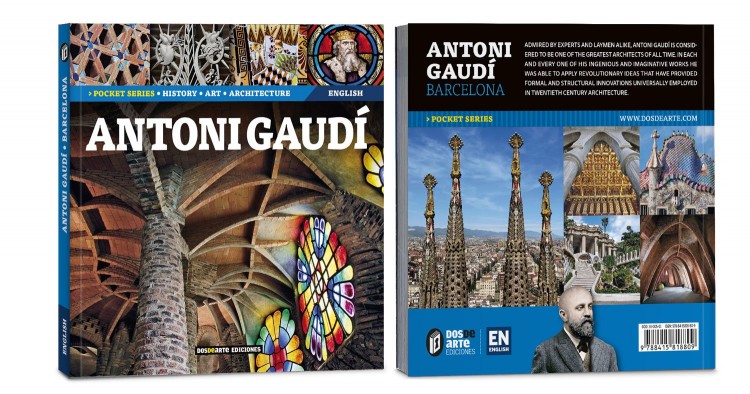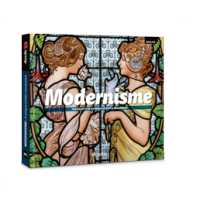Antoni Gaudí
History, art, architecture
RETURN
About the book Antoni Gaudí
Admired by experts and laymen alike, Antoni Gaudí is considered one of the most important architects in history. The different projects that make up his extensive legacy reveal a personal and inimitable language, packed with revolutionary technical and symbolic ideas.
The first works of Gaudí, which include Casa Vicens, the Caprice and Finca Güell, show the influence of Oriental art. In later works, such as Güell Palace, Casa Botines and the Episcopal Palace of Astorga, the architect incorporated elements typical of the neo-Gothic style.
Already in his mature period, when he designed Casa Batlló, Park Güell and La Pedrera, amongst others, Gaudí did away with historicist influences in order to seek inspiration from nature. The artistic growth of the architect is reflected in the Sagrada Familia, the masterpiece that Gaudí dedicated most of his life to.
This paperback shows Gaudí's constant evolution, grouping together the architect's works into his different stylistic periods. The book shows the origins and the peculiarities of each project, at the same time as it reveals the sources of inspiration of one of the key figures of Modernisme.
The first works of Gaudí, which include Casa Vicens, the Caprice and Finca Güell, show the influence of Oriental art. In later works, such as Güell Palace, Casa Botines and the Episcopal Palace of Astorga, the architect incorporated elements typical of the neo-Gothic style.
Already in his mature period, when he designed Casa Batlló, Park Güell and La Pedrera, amongst others, Gaudí did away with historicist influences in order to seek inspiration from nature. The artistic growth of the architect is reflected in the Sagrada Familia, the masterpiece that Gaudí dedicated most of his life to.
This paperback shows Gaudí's constant evolution, grouping together the architect's works into his different stylistic periods. The book shows the origins and the peculiarities of each project, at the same time as it reveals the sources of inspiration of one of the key figures of Modernisme.
Pocket Edition
Antoni Gaudí
It includes exclusive digital content
Made with environmentally friendly paper
Multilanguage: Available in 8 languages
More than 120 pictures and detailed info
About the book Antoni Gaudí
Admired by experts and laymen alike, Antoni Gaudí is considered one of the most important architects in history. The different projects that make up his extensive legacy reveal a personal and inimitable language, packed with revolutionary technical and symbolic ideas.
The first works of Gaudí, which include Casa Vicens, the Caprice and Finca Güell, show the influence of Oriental art. In later works, such as Güell Palace, Casa Botines and the Episcopal Palace of Astorga, the architect incorporated elements typical of the neo-Gothic style.
Already in his mature period, when he designed Casa Batlló, Park Güell and La Pedrera, amongst others, Gaudí did away with historicist influences in order to seek inspiration from nature. The artistic growth of the architect is reflected in the Sagrada Familia, the masterpiece that Gaudí dedicated most of his life to.
This paperback shows Gaudí's constant evolution, grouping together the architect's works into his different stylistic periods. The book shows the origins and the peculiarities of each project, at the same time as it reveals the sources of inspiration of one of the key figures of Modernisme.
The first works of Gaudí, which include Casa Vicens, the Caprice and Finca Güell, show the influence of Oriental art. In later works, such as Güell Palace, Casa Botines and the Episcopal Palace of Astorga, the architect incorporated elements typical of the neo-Gothic style.
Already in his mature period, when he designed Casa Batlló, Park Güell and La Pedrera, amongst others, Gaudí did away with historicist influences in order to seek inspiration from nature. The artistic growth of the architect is reflected in the Sagrada Familia, the masterpiece that Gaudí dedicated most of his life to.
This paperback shows Gaudí's constant evolution, grouping together the architect's works into his different stylistic periods. The book shows the origins and the peculiarities of each project, at the same time as it reveals the sources of inspiration of one of the key figures of Modernisme.
Readers opinions
(6)
RETURN
Reviews
(6)
I was happy with the book. It was excellent!
I liked the content, ang the infographics are very good. The book fulfilled my expectations.
I really loved the book, but perhaps adding references and providing extra bibliographic information would benefit people like me who write more in depth about travel and architecture.
An excellent book about Gaudí.
The entire book seemed perfect to me in order to get to know Gaudí and his works better.
Nice book! The illustrations and infographics are very good.
Readers opinions
(6)
I was happy with the book. It was excellent!
I liked the content, ang the infographics are very good. The book fulfilled my expectations.
Additional Information
- Additional Information
- Subtitle: History, art, architecture
- Weight (g): 290
- Binding: Paperback with flaps
- Size (cm): 17,5 x 19,5
- Author: Dosde
- Pages: 0
- Edition: Pocket Edition
The style of Gaudí's works
Born in 1852 in Reus (Tarragona), Antoni Gaudí i Cornet is considered as the greatest exponent of Catalan Modernism and one of the leading lights of the Art Nouveau movement in Europe, despite his architecture evolving into such a personal style that it is rather difficult to classify.
From a youthful period marked by Historicism, Gaudí evolves towards a totally original style, based on the observation of nature, from which he extracts structures as innovative as the catenary arch. This evolution gives rise to an organic style of architecture, totally avant-garde whilst cemented in tradition.
Gaudí started his career very much influenced by the Eclectic style, developed in Europe in the 19th century. Casa Vicens and the Caprice are two of the works where this artistic phase of the architect can be appreciated, who started to outline an artistic style that moved further and further away from orthodoxy.
The neo-Gothic architecture, a genre that evoke the most prosperous period in the history of Catalonia, marked the formative years of Antoni Gaudí. The architect took on this constructive language in a natural way and incorporated it into some of his most important works of in the late nineteenth century, from Güell Palace up to Torre Bellesguard, including the Episcopal Palace of Astorga, the Teresian College, Casa Botines and the Güell Winecellars.
From a youthful period marked by Historicism, Gaudí evolves towards a totally original style, based on the observation of nature, from which he extracts structures as innovative as the catenary arch. This evolution gives rise to an organic style of architecture, totally avant-garde whilst cemented in tradition.


























